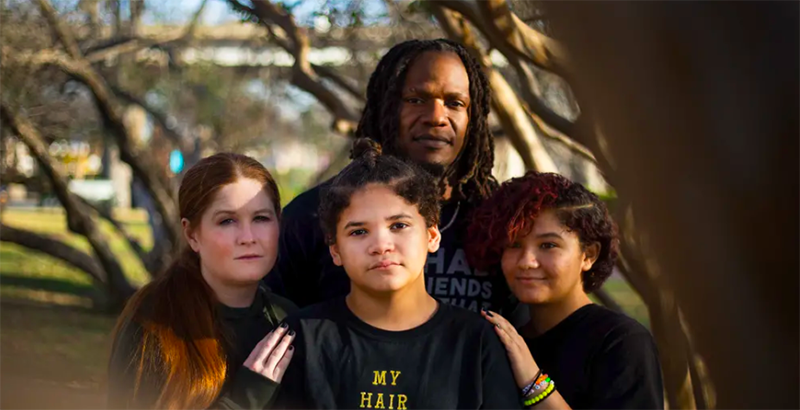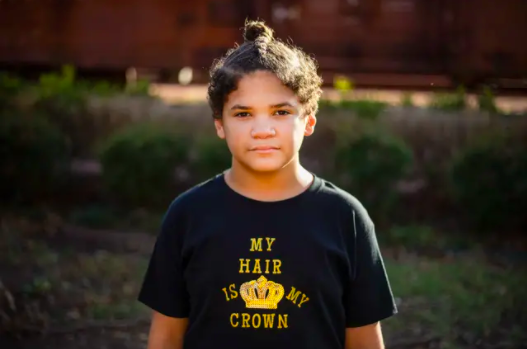Texas Schools Rethink Gender-Based Dress Code Policies After Discrimination Claims Raise New Legal Issues

Hope Cozart was perplexed when she received a letter from her son Maddox’s school in April telling her he needed to cut his hair because it was too long. Even so, she obliged: She took Maddox to get a haircut, which consisted of shaved sides with a little more hair left at the top. Cozart would braid or plait her son’s hair to keep it out of his face.
But school officials from the Troy Independent School District, where Maddox was enrolled at Raymond Mays Middle School, outside of Temple, were still unhappy with the new cut. He was disciplined for breaking his school’s dress code, which at the time prohibited male students from wearing their hair in a ponytail, bun or top knot. Maddox was placed in in-school suspension for more than 10 days and later in lunch detention, Cozart said. Her daughter, who had a similar hairstyle, never faced any issues.
“He was getting pulled out of class daily, sometimes by multiple teachers, and examined like he was an object,” said Cozart, noting that her son is biracial and that his hair style relates to his Black culture. “One time they called in three different people to examine his head to make sure that it was OK for him to be in class.”
Cozart’s experience is part of a series of recent conflicts across the state over school dress codes, some of which have turned into civil rights court battles over gender and race.
In the Houston area, a lawsuit filed against Magnolia ISD in October accused the district of violating Title IX and students’ 14th Amendment protections by prohibiting male students from wearing long hair. This month, the district’s school board reached a settlement agreement and voted to eliminate its gender-based policy on hair.

Their decision comes more than a year after a similar lawsuit involving two Black male students who wore their hair in dreadlocks while attending Barbers Hill ISD, also near Houston, and were punished for breaking the district’s hair length policy for male students. The lawsuit is still ongoing, and the district’s policy is still in place.
Legal experts say school districts have had wide freedom in crafting dress codes and grooming policies for decades, but they believe those rules — particularly those that directly or indirectly single out specific groups by gender or race — are approaching an inflection point where reassessment is necessary.
“For many years, [dress codes] were sort of a set it and forget it [policy] for school districts,” said Joy Baskin, director of legal services for the Texas Association of School Boards, a nonprofit group that represents local school boards across the state, helps review districts’ policies and provides assistance on how to navigate legal developments affecting Texas public schools. “They had set their policies or procedures in their handbooks and left them in place for many, many years without reexamination, but in light of current challenges and attention being brought to dress and grooming, I think it’s been recently an area of greater attention.”
Creating the rules
Cozart publicized her son’s ordeal on social media in hopes of putting pressure on the school to change its hair policy, and the incident gained plenty of local attention. She considered taking legal action alleging gender and racial discrimination, but she ended up not doing so after the district sped up an in-depth review of its dress code policy, which happens every three years.
Troy ISD Superintendent Neil Jeter said changes were made to the dress code as part of the regular review process, which included a districtwide survey and happened to align with Cozart’s complaints. The district introduced a more gender-neutral policy that no longer specifies that hair should be worn at a certain length or limited to specific styles based on gender.
In Texas, school districts’ dress codes are largely determined at an administrative level. While drafting new rules, school administrators may consult and receive input from school boards, students and parents, Baskin said, but ultimately they are not required to do so. There’s no standardized process sanctioned by the state for creating or reviewing dress codes.
Ultimately, school districts seem to agree that educators need some guidance on what kind of styles are permitted among students. Some reasons listed in Texas school districts’ policies to explain the inclusion of dress codes include the need to “instill discipline,” “prevent disruption” and “teach grooming and hygiene.”
Although Jeter agrees that dress codes are subject to scrutiny and review, he said they’re still needed to help keep students focused on their education.
“I do believe that how students dress can help set the environment for a good educational experience, so they’re focusing on their studies instead of the latest trend or fad,” Jeter said.
It’s not uncommon for school districts to have gender-based guidelines in their dress codes. In September 2020, the American Civil Liberties Union of Texas found that out of the 1,000-plus school districts in Texas, nearly 500 had gender-specific provisions in place as part of their dress codes.

The Texas Education Code mentions how school boards can adopt rules about school uniforms, but not dress and grooming codes. According to the Texas Education Agency, which oversees public education in the state, districts are authorized “to adopt dress codes which may apply differently on a gender basis.” The Texas Association of School Boards advises its members that although districts have rather broad authority when it comes to instituting dress code policies, they should consider diverse perspectives when crafting policies.
“Obviously, the world is changing and there’s more awareness among courts about the potential for the impact of practices that may be intended to be generic, but in fact have a discriminatory impact,” Baskin said.
Dress codes under a new light
Many Texas school districts defend their dress codes based on a pair of Texas Supreme Court rulings from the 1990s that concluded it was not discriminatory for school dress and grooming codes to differentiate based on gender, said Brian Klosterboer, a staff attorney with the ACLU of Texas.
However, federal courts outside of Texas have ruled in recent years that gender-based dress codes could be classified as gender discrimination under Title IX, a federal law that prohibits discrimination in educational settings on the basis of sex.
“I think that these [gender-based] policies under modern case law are pretty clearly unconstitutional and illegal, and it’s past time for districts to update them,” Klosterboer said.
According to Andrew Siegel, a law professor at Seattle University and co-author of “Of Dress and Redress: Student Dress Restrictions in Constitutional Law and Culture,” legal arguments examining whether a dress code policy is discriminatory under federal law or violates equal rights protections are a shift from the First Amendment arguments that that were once at the center of legal challenges to school dress codes.
Until the late 1960s, students’ appearance in U.S. public schools was mostly dictated by unspoken societal norms and expectations, with formal dress codes being a rare tool, Siegel said. As culture shifted, young people began to adopt new clothing styles and habits, and the pushback led to the adoption of dress code guidelines.
The clash led to litigation, including the landmark 1968 U.S. Supreme Court case Tinker v. Des Moines Independent Community School District, in which justices ruled that students’ right to freedom of speech did not end when they entered school doors. Under the ruling, schools cannot suppress student speech unless they can prove it would interfere with school operations. As more litigation sprouted, the enforcement of dress code guidelines began to dissipate, Siegel said.
“Back in the ’60s and early ’70s, before schools kind of voluntarily did away with these various codes and uniforms, there was a developing legal movement to provide broad rights to students, and that’s kind of disappeared,” Siegel said.
According to Siegel’s research, trends in politics, policing, parenting and race relations in the 1980s and 1990s led to a reemergence of uniform policies and dress code restrictions being implemented in schools, with courts empowering schools with greater latitude to control and monitor students’ style choices.
But fresh concerns over discrimination have pushed some school districts to ensure their dress code policies reflect modern times. Jeter, the Troy ISD superintendent, said his district made sure to consult with its attorneys when revising its school dress code.
“We were also influenced by the legal tone in our nation right now, specifically regarding gender,” he said.
Impact on students of color
In some instances, dress codes have also been challenged over potentially discriminatory treatment on the basis of race and ancestry or religion. This year, the ACLU of Texas has sent at least two complaints to the U.S. Department of Education’s Office of Civil Rights concerning male students of Native American heritage being punished for wearing their hair long, which aligns with their cultural and religious beliefs, according to the organization.
Mahogane Reed, an attorney with the NAACP’s Legal Defense Fund, said the 2020 case of the Black male students who were disciplined for wearing dreadlocks at Barbers Hill ISD illustrates how sometimes students are caught at an intersection of identities and can be affected by school dress codes that don’t account for cultural intricacies.
“I don’t know that we have a standard set of provisions that sort of completely eradicate any form of discrimination and enforcement of policies, but certainly gender-based hair policies or policies that are enforced in such a way that disparately impact minority students [and] students of color [are] not the answer,” Reed said.
Binary dress codes have also presented a dilemma for LGBTQ and nonbinary students such as Danielle Miller’s fifth grade child, Tristan, who is nonbinary and one of the seven plaintiffs in the lawsuit against Magnolia ISD.
“When I explained that we would have to adhere to a boy’s dress code [to Tristan], it was just met with complete trauma, and I realized that we weren’t going to be cutting their hair and we’re going to have to do everything we had to to go ahead and fight this because it’s not OK,” Miller said during a media briefing with the ACLU.
For Ryder Appleton, superintendent of Mexia ISD near Waco, dress codes are “not a one-size-fits-all” approach, especially considering the racial and gender diversity in his district, he said.
The district reviews its dress code annually, Appleton said, and this year it made notable changes: It got rid of its hair length policy, allowed both female and male students to wear earrings, and permitted tattoos as long as they’re not “offensive, vulgar or inappropriate.” Ultimately, Appleton said, the district wants to focus on keeping students in school and in class, especially after dealing with a high level of absences because of the pandemic.
“I think recently, [the] dress code was looked at as almost like a list of Ten Commandments, of ‘thou shalt not do this or that,’ and we have deployed more of a New Testament version of ‘let’s look at the intentions of a person,’” Appleton said. “It’s open as opposed to more restrictive.”
Baskin said changes in the state’s demographics could also have contributed to the increase in complaints against school dress codes. Results from last year’s census show that 95% of the state’s growth since 2010 was fueled by people of color.
“I think the reason Texas stands out in terms of the national conversation is that we have such a variety of districts,” Baskin said. “We have growth in Texas that causes places that were once rural to become more suburban, and our rapid growth or demographic change has allowed really there to be more transitions and more awareness brought to these issues.”

Although Troy ISD has now adopted a new dress code policy, Cozart said she chose not to let two of her children return to in-person classes this year because of what her son Maddox went through and other incidents in which her daughter was called racial slurs. (In a statement, Jeter said Troy ISD “investigates and responds to allegations regarding racial slurs” and that it did not receive any allegations of racial slurs from Cozart in a “formal grievance.”)
Since the clash over Maddox’s hair, the family has shown support for the CROWN Act, legislation that would prohibit hair discrimination in schools and the workplace. It was voted out of committee during this year’s regular session but was not taken up on the House floor for a vote. A spokesperson for the bill’s lead author, state Rep. Rhetta Bowers, D-Garland, said the lawmaker plans to reintroduce the legislation during the next regular session.
Cozart and her family are looking to move to a new area outside of Troy. She said her kids have requested to go to a school “where there’s people who look like us.”
“I just want them to feel comfortable and safe where they’re going [to school],” Cozart said of her children. “Because where they were at, they didn’t feel comfortable and safe.”
Allyson Waller is a general assignment reporter at The Texas Tribune, the only member-supported, digital-first, nonpartisan media organization that informs Texans about public policy, politics, government and statewide issues.
Disclosure: The Texas Association of School Boards and the ACLU of Texas have been financial supporters of The Texas Tribune, a nonprofit, nonpartisan news organization that is funded in part by donations from members, foundations and corporate sponsors. Financial supporters play no role in the Tribune’s journalism. Find a complete list of them here.
Get stories like these delivered straight to your inbox. Sign up for The 74 Newsletter

;)